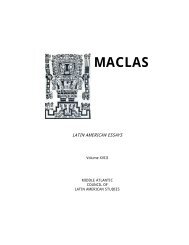latin american essays maclas
latin american essays maclas
latin american essays maclas
You also want an ePaper? Increase the reach of your titles
YUMPU automatically turns print PDFs into web optimized ePapers that Google loves.
“CONSTRUCTING MEMORY THROUGH TECHNOLOGY:<br />
BRAND NEW MEMORY BY ELĺAS MIGUEL MUÑOZ<br />
Isabel Valiela<br />
Gettysburg College<br />
Elías Miguel Muñoz is a Cuban-American writer who belongs to the “oneand-a-half<br />
generation,” a term first coined by Cuban sociologist Rubén G.<br />
Rumbaut. It refers to immigrant children who were taken from their homeland<br />
during childhood or young adolescence, beginning their journey into adulthood in<br />
the United States. In Rumbaut’s study on migration and adaptation of<br />
Indochinese refugee adults and children, he coins this term which will eventually<br />
be adopted to apply to other groups as well:<br />
Children who were born abroad but are being educated and come of<br />
age in the United States form what may be called the “1.5” generation.<br />
These refugee youth must cope with two crisis-producing and identitydefining<br />
life transitions: (1) adolescence and the task of managing the<br />
transition from childhood to adulthood, and (2) acculturation and the<br />
task of managing the transition from one sociocultural environment to<br />
another. The “first” generation of their parents, who are fully part of the<br />
“old” world, face only the latter; the “second” generation of children<br />
being born and reared in the United States, who as such are fully part of<br />
the “new” world, will need to confront only the former. But members of<br />
the “1.5” generation form a distinctive cohort in that in many ways they<br />
are marginal to both the old and the new worlds, and are fully part of<br />
neither of them. Still they need to search for an identity and define<br />
themselves with respect both to their society of origin, to which they<br />
may never return, and to the adoptive society where they are being<br />
formed, which itself is rapidly changing. (Rumbaut 61)<br />
Elías Miguel Muñoz and the “One-and-a-Half” Generation<br />
Gustavo Pérez Firmat, who was brought to the U.S. from Cuba by his<br />
parents at the age of eleven, popularized the term “one-and-a-half generation”<br />
in his book Life on the Hyphen: The Cuban-American Way, applying it specifically<br />
to his generation of Cuban-Americans. One of the main theses of Pérez-Firmat’s<br />
book is that Cuban-American culture is to a large extent an achievement of his<br />
generation (4), and therefore, it is significant to explore how this group worked<br />
through its unique marginalities. Other well-know writers who belong to this<br />
generational group are Cristina García, Roberto G. Fernández, Virgilio Suárez,<br />
and Achy Obejas. 1 This group is marked by a strong need to explore the issue of<br />
identity, and their work shows the many ways in which “Cubanidad” (Cubanity)<br />
110




